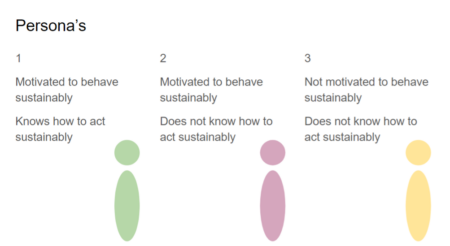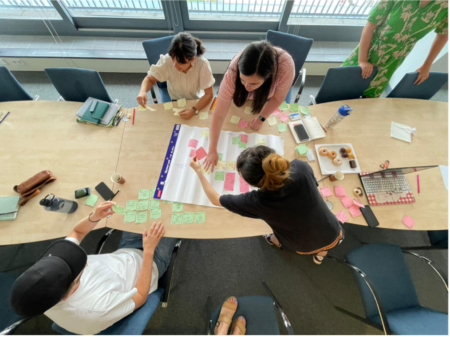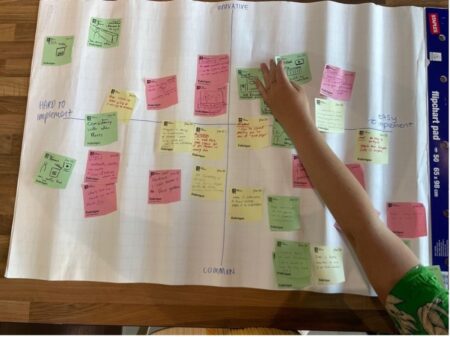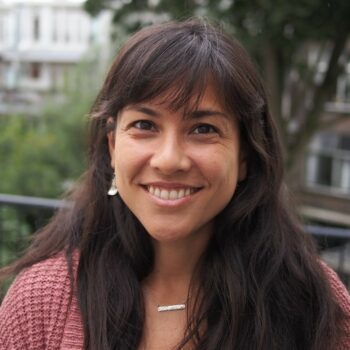How can we motivate passengers to act sustainably in an airport environment?
by Nika den Ouden & Anniek Keijer
August 9, 2023

Creative sessions can create valuable insights by immersing in personas
Introduction
To gain insights about a certain user group, a researcher can gather specific users they are interested in and involve them in a creative session to learn about the users’ perspectives or insights about a product or situation. This problem can be solved by creating an environment where designers can submerge themselves within a certain user and setting. This creative process can be enhanced by asking the user group to consider a situation through the eyes of someone they know. In this blog post, we will discuss how we used a persona approach in a creative session to gain insights into passenger behaviour in an airport environment. We also provide some tips if you would like to conduct your own creative session using the persona approach.
Immersing in personas
In a “persona approach,” a researcher can gather insights into different types of scenarios by asking participants to play a “persona” or character in a creative session. The participants of the session are assigned a certain user persona, with specific viewpoints on a situation. The participant will then prepare to have a certain mindset which resonates with the assigned persona. To improve the participants’ relation to their assigned user persona, they are asked to think of someone in their social circles that would fit the characteristics of the persona. For instance, that one neighbour that is already stressed about his next holiday in November or maybe your grandma who has a hard time throwing anything away.
one of the three personas we developed. We then provided them with a corresponding colour of sticky notes. Subsequently, we discussed what these personas meant and if the participants had any questions about them so they were prepared to get into the role of the personas. Important here is to record the meeting, as this can give more insights into understanding decisions that the participants made, and so to decisions your user group would make.

For our projects, we were interested in how to motivate different types of passengers (i.e., users) at Schiphol Airport to dispose of their waste whilst waiting to board at the gate. We came up with three different personas in an airport environment which we showed and explained to the participants (see Figure 1).
The creative session

A creative session with other people can help to identify solutions that you might not have thought of alone or within your immediate team. A creative session where one tries to view the problem from a different perspective can potentially highlight solutions or underlying causes that may not have been considered before.
The creative session can start with a brain dump: writing down or sketching any first ideas they already had on their minds to solve the problem. This way, the more obvious ideas are written down to make room in the participants’ minds for new ideas in the next phase. Examples of some solutions provided during the brain dump were: a statement voting bin, a bin that you could play games with or waste that is connected to an app to give you certain credits by doing it right!
After this brain dump, you can steer the participants in directions for ideas, for example: How would your persona be motivated to separate waste correctly? Or: How would it be motivated to hand back in its deposit water bottle? In this way, the participants can be given more guidance on different results. When the brainstorming phase is finished, these ideas can be clustered and evaluated by using the C-Box method (Heijne and Van der Meer, 2019). This method helps categorise large numbers of ideas by using a matrix to map these ideas based on their innovativeness and feasibility.
Insights and tips if you want to apply this in your project
The goal of this special creative session was to gain insights about the different types of user groups whilst at the same time gaining ideas for potential solutions. During this whole session, lots of insights can pop up at random moments, so make sure you can take notes, record the session, ask the participants to think out loud and ask questions if you do not understand a certain decision of a participant. Also, give the participants room to ask questions about their role, so that for them it is clear whom they are representing. In this way, if a participant says something that their persona would do, you can write this down and use it as directions later in your process. During the brainstorming phase, insights can be gained by inspiring the participants and by asking them questions related to the context they should immerse themselves in. Also check what is on their sticky notes, so that if you do not completely understand they can elaborate on this more. Furthermore, by looking at the C-Box again after the session, you can find opportunities for a solution by asking yourself: ‘How can I change this idea to move it into a more relevant quadrant?’
A fun way to end the session is to let the participants present a visual concept from the idea that they think would work best, which you can also do in groups. Give them 10 minutes to pick an idea and draw this idea into a more detailed concept, it helps to let them give their concept a name and point out its unique selling points. In this way, the session is rounded and you end up with some concepts that have more form than just words on a sticky note.
Our last tip for you, if you would like to apply this to your project, is to be flexible! Of course, plan your session, write down what you want to do and how much time you think this will cost. Invite your participants and give them an indication of this schedule and planning. However, the nature of a creative session is that people can be free to write and say everything they want, so you don’t want to stop them at the peak of their creative flow. So, if the session seems to go into a side-track, or if it takes longer than expected, see this as an opportunity to gain even more insights!

Good luck with your sessions, if you have any questions, you can always reach out to either one of us!
About the authors
Nika van Ouden, Graduation Student
Anniek Keijer, Graduation Student
